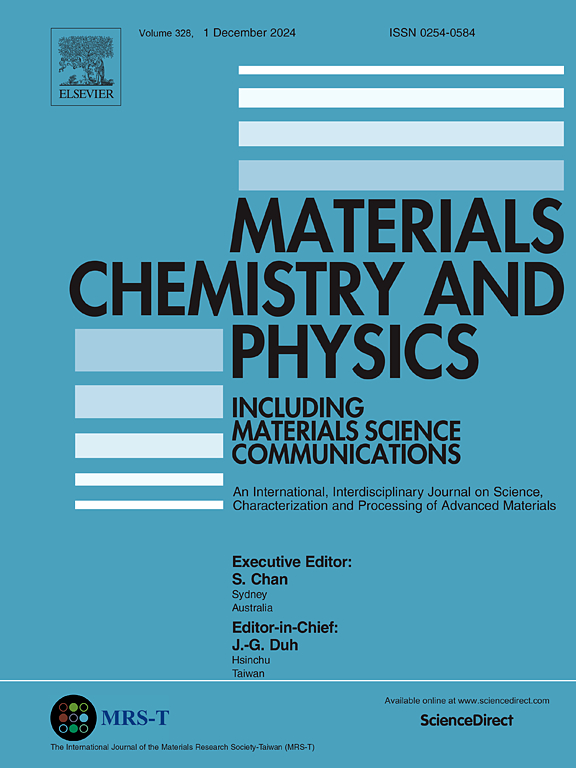退火温度对WO3演化结构、内部缺陷及X和γ辐射屏蔽的影响
IF 4.3
3区 材料科学
Q2 MATERIALS SCIENCE, MULTIDISCIPLINARY
引用次数: 0
摘要
目前的研究主要集中在材料的粒度上,以潜在地提高它们抵御电离辐射的能力。本研究首次研究了高温退火后WO3的微观结构变化及其对电离辐射屏蔽的影响。随着退火温度的升高,合成的样品呈现出明显的颜色变化。XRD和拉曼测量证实了单斜相γ-WO3。退火诱导的WO3形貌变化表明,在500°C时,WO3颗粒主要为纳米棒状,而在700°C时,WO3颗粒呈六边形纳米片状。值得注意的是,纳米片的平均粒径在950°C时下降,然后在1100°C时上升到微尺度。通过等温吸附-解吸和正电子湮灭寿命(PAL)分别揭示了退火工艺对气孔和缺陷的抑制作用。总的来说,提高温度对样品的X射线和γ射线衰减有积极的影响。多变量分析突出了影响辐射屏蔽的关键参数。而根据能量的不同,x射线的衰减与某些微观结构因素有明显的相关性,包括粒径、晶粒尺寸和孔隙特征,而γ射线的衰减主要只依赖于缺陷特征。结果表明,单纯依靠粒径是不够的,在评价材料的屏蔽性能时,需要考虑相关的微观结构因素。这项研究为WO3的结构特性及其在辐射屏蔽方面的潜在应用提供了有价值的见解,强调了进一步研究建立精确的材料特异性指南的必要性。本文章由计算机程序翻译,如有差异,请以英文原文为准。
Impact of annealing temperatures on evolutionary structure, internal defects, and X- and Gamma-Radiation Shielding in WO3
Current research focuses exclusively on the particle size of materials to potentially enhance their ability to protect against ionizing radiation. This research investigates, for the first time, the microstructural alterations in WO3 annealed at elevated temperatures and their effects on ionizing radiation shielding. The synthesized samples exhibited distinct color changes with increasing annealing temperatures. XRD and Raman measurements confirmed the monoclinic γ-WO3 phase. The annealing-induced morphological transformations of WO3 show that at 500 °C, the particles are predominantly nanorods, whereas at 700 °C, they resemble hexagonal-like nanosheets. Notably, the mean particle size of the nanosheets drops at 950 °C and then rises to a microscale at 1100 °C. The annealing process plays a crucial role in mitigating pores and defects, revealed by isothermal adsorption-desorption and positron annihilation lifetime (PAL), respectively. In general, raising the temperature has a positive effect on the X- and γ-ray attenuation of the samples. Multivariate analysis highlighted the key parameters influencing radiation shielding. While, depending on the energy, X-ray attenuation has distinct correlations with certain microstructural factors, including particle size, crystallite size, and pore characteristics, the attenuation of γ-ray is primarily dependent only on defect characteristics. The results demonstrate that relying solely on particle size is inadequate and that the interrelated microstructural factors need to be taken into account when evaluating the shielding properties of materials. This study offers valuable insights into the structural characteristics of WO3 and its potential applications in radiation shielding, emphasizing the necessity for further studies to establish precise material-specific guidelines.
求助全文
通过发布文献求助,成功后即可免费获取论文全文。
去求助
来源期刊

Materials Chemistry and Physics
工程技术-材料科学:综合
CiteScore
8.70
自引率
4.30%
发文量
1515
审稿时长
69 days
期刊介绍:
Materials Chemistry and Physics is devoted to short communications, full-length research papers and feature articles on interrelationships among structure, properties, processing and performance of materials. The Editors welcome manuscripts on thin films, surface and interface science, materials degradation and reliability, metallurgy, semiconductors and optoelectronic materials, fine ceramics, magnetics, superconductors, specialty polymers, nano-materials and composite materials.
 求助内容:
求助内容: 应助结果提醒方式:
应助结果提醒方式:


